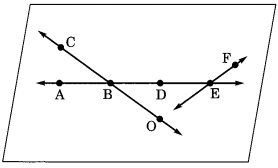NCERT Solutions for Class 6 Maths Chapter 4 Basic Geometrical Ideas Ex 4.1
Exercise 4.1
Ex 4.1 Class 6 Maths Question 1.
Use the figure to name:
(a) Five points
(b) A line
(c) Four rays
(d) Five line segments
Solution:
(a) Five points are: O, B, C, E and D
NCERT Solutions for Class 6 Maths Chapter 4 Basic Geometrical Ideas

(b) Name of the line is DB←→ or BD←→.
(c) Four rays are: OC−→−, OB−→−, OE−→− and OD−→−
(d) Five line segments are:
OE¯¯¯¯¯¯¯¯, ED¯¯¯¯¯¯¯¯, OD¯¯¯¯¯¯¯¯, OB¯¯¯¯¯¯¯¯ and EB¯¯¯¯¯¯¯¯.
Ex 4.1 Class 6 Maths Question 2.
Name the line given in all possible (twelve) ways, choosing only two letters at a times from the four given.

Solution:
The given lines can be named as follows:

Ex 4.1 Class 6 Maths Question 3.
Use the figure to name:
(a) Line containing point E.
(b) Line passing through A.
(c) Line on which 0 lies.
(d) Two pairs of intersecting lines.

Solution:
(a) EF←→
(b) AE←→
(c) BC←→ or BO←→
(d) CO←→ or AE←→ or AE←→ or EF←→
Ex 4.1 Class 6 Maths Question 4.
How many lines can pass through
(a) one given point?
(b) two given points?
Solution:
(a) Infinitely many lines can pass through a given points.
(b) Only one line can pass through two given points.
Ex 4.1 Class 6 Maths Question 5.
Draw a rough figure and label suitably in each of the following cases:
(a) Point P lies on AB¯¯¯¯¯¯¯¯.
(b) XY←→ and PQ←→ intersect at M.
(c) Line L contains E and F but not D.
(d) OP←→ and OQ←→ meet at O.
Solution:

Ex 4.1 Class 6 Maths Question 6.
Consider the following figure of line MN. Say whether following statements are true or false in context of the given figure.

NCERT Solutions for Class 6 Maths Chapter 4 Basic Geometrical Ideas
(a) Q, M, O, N, P are points on the line MN←→−.
(b) M, O, N are points on a line segment MN¯¯¯¯¯¯¯¯¯¯.
(c) M and N are end points of line segment MN¯¯¯¯¯¯¯¯¯¯.
(d) O and N are end points of line segment OP¯¯¯¯¯¯¯¯ .
(e) M is one of the end points of line segment QO¯¯¯¯¯¯¯¯.
(f) M is point on ray OP−→−.
(g) Ray OP←→ is different from ray QP−→−.
(h) Ray OP←→ is same as ray OM−→− .
(i) Ray OM−→− is not opposite to ray OP←→.
(j) O is not an initial point of OP←→.
(k) N is the initial point of NP−→− and NM−→−.
Solution:
(a) True
(b) True
(c) True
(d) False
(e) False
(f) False
(g) True
(h) False
(i) False
(j) False
(k) True